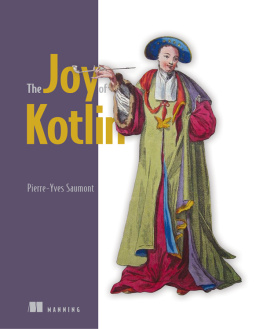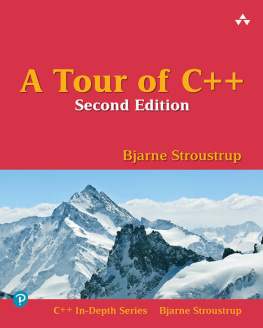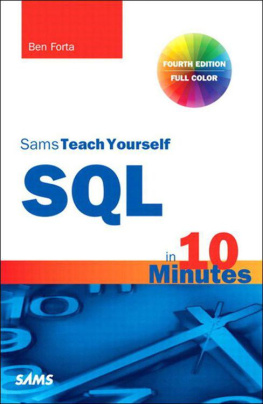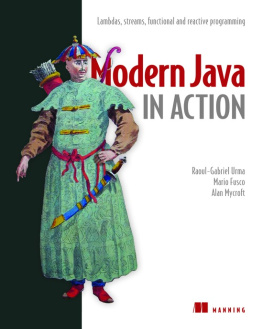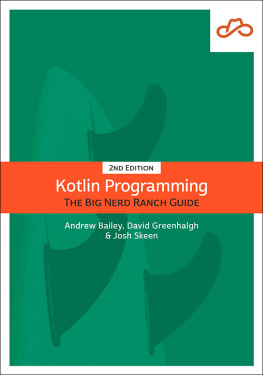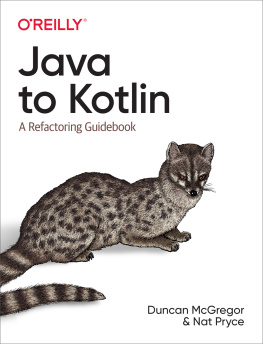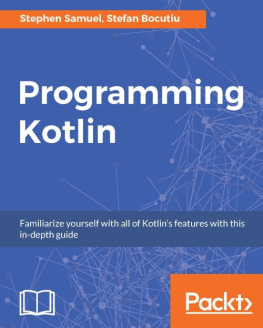Safari an OReilly Media Company. - The Joy of Kotlin
Here you can read online Safari an OReilly Media Company. - The Joy of Kotlin full text of the book (entire story) in english for free. Download pdf and epub, get meaning, cover and reviews about this ebook. City: Manning Publications, year: 2019, publisher: Manning Publications, genre: Computer. Description of the work, (preface) as well as reviews are available. Best literature library LitArk.com created for fans of good reading and offers a wide selection of genres:
Romance novel
Science fiction
Adventure
Detective
Science
History
Home and family
Prose
Art
Politics
Computer
Non-fiction
Religion
Business
Children
Humor
Choose a favorite category and find really read worthwhile books. Enjoy immersion in the world of imagination, feel the emotions of the characters or learn something new for yourself, make an fascinating discovery.
- Book:The Joy of Kotlin
- Author:
- Publisher:Manning Publications
- Genre:
- Year:2019
- City:Manning Publications
- Rating:5 / 5
- Favourites:Add to favourites
- Your mark:
The Joy of Kotlin: summary, description and annotation
We offer to read an annotation, description, summary or preface (depends on what the author of the book "The Joy of Kotlin" wrote himself). If you haven't found the necessary information about the book — write in the comments, we will try to find it.
Maintaining poor legacy code, interpreting cryptic comments, and writing the same boilerplate over and over can suck the joy out of your life as a Java developer. Fear not! Theres hope! Kotlin is an elegant JVM language with modern features and easy integration with Java.The Joy of Kotlinteaches you practical techniques to improve abstraction and design, to write comprehensible code, and to build maintainable bug-free applications.
Purchase of the print book includes a free eBook in PDF, Kindle, and ePub formats from Manning Publications.
About the Technology
Your programming language should be expressive, safe, flexible, and intuitive, and Kotlin checks all the boxes! This elegant JVM language integrates seamlessly with Java, and makes it a breeze to switch between OO and functional styles of programming. Its also fully supported by Google as a first-class Android language. Master the powerful techniques in this unique book, and youll be able to take on new challenges with increased confidence and skill.
About the Book
The Joy of Kotlinteaches you to write comprehensible, easy-to-maintain, safe programs with Kotlin. In this expert guide, seasoned engineer Pierre-Yves Saumont teaches you to approach common programming challenges with a fresh, FP-inspired perspective. As you work through the many examples, youll dive deep into handling errors and data properly, managing state, and taking advantage of laziness. The authors down-to-earth examples and experience-driven insights will make you a betterand more joyfuldeveloper!
Whats inside
Programming with functions
Dealing with optional data
Safe handling of errors and exceptions
Handling and sharing state mutation
About the Reader
Written for intermediate Java or Kotlin developers.
About the Author
Pierre-Yves Saumontis a senior software engineer at Alcatel-Submarine Networks. Hes the author ofFunctional Programming in Java(Manning, 2017).
Table of Contents
Making programs safer
Functional programming in Kotlin: An overview
Programming with functions
Recursion, corecursion, and memoization
Data handling with lists
Dealing with optional data
Handling errors and exceptions
Advanced list handling
Working with laziness
More data handling with trees
Solving problems with advanced trees
Functional input/output
Sharing mutable states with actors
Solving common problems functionally
Safari an OReilly Media Company.: author's other books
Who wrote The Joy of Kotlin? Find out the surname, the name of the author of the book and a list of all author's works by series.

